Supreme Court Bans Protests at Supreme Court but Not Near the Supreme Court
The AP has the Supreme Court banning demonstrations at the Supreme Court. The regulation in question doesn't actually do that.
An AP story making the rounds has the Supreme Court banning demonstrations at the Supreme Court. The regulation in question doesn’t actually do that.
AP (“Supreme Court Bans Protests On Its Grounds“):
The Supreme Court has come up with a new regulation banning demonstrations on its grounds, two days after a broader anti-demonstration law was declared unconstitutional.
The regulation bans activities on the court’s grounds or building such as picketing, speech-making, marching, vigils or religious services “that involve the communication or expression of views or grievances, engaged in by one or more persons, the conduct of which is reasonably likely to draw a crowd or onlookers.”
It says that “casual use by visitors or tourists” that isn’t likely to attract a crowd is not banned. That may be a way of addressing the concern posed by a federal judge who threw out the law barring processions and expressive banners on the court’s grounds.
In her ruling Tuesday, U.S. District Judge Beryl Howell said that law was so broad it could criminalize preschool students parading on their first field trip to the high court. She also wrote that the marshal of the Supreme Court “has the authority to prescribe necessary regulations to govern the plaza,” which is what the marshal did Thursday.
Howell was ruling in a challenge brought by Harold Hodge Jr., who was arrested on the Supreme Court plaza in January 2011 while wearing a sign that criticized police treatment of blacks and Hispanics.
He was given a citation for violating a law that makes it a crime to “parade, stand, or move in processions or assemblages,” or to display a “flag, banner, or device designed or adapted to bring into public notice a party, organization, or movement,” at the high court’s building or grounds.
The new regulation can be found on the Supreme Court website, on the page marked, “Building Regulations,” with a note that they have been “prescribed by the Marshal and approved by the Chief Justice of the United States.”
The 1st Amendment declares that “Congress shall make no law . . . abridging the freedom of speech . . . or the right of the people peaceably to assemble.” It doesn’t say anything about the Supreme Court issuing regulations. But I kid; of course Americans have a right to picket the Supreme Court.
What’s going on here? That page referred to at the end of the AP excerpt is not exactly prominently displayed on the site but here it is:
REGULATION SEVEN This regulation is issued under the authority of 40 U.S.C. § 6102 to protect the Supreme Court building and grounds, and persons and property thereon, and to maintain suitable order and decorum within the Supreme Court building and grounds. Any person who fails to comply with this regulation may be subject to a fine and/or imprisonment pursuant to 40 U.S.C. § 6137. This regulation does not apply on the perimeter sidewalks on the Supreme Court grounds. The Supreme Court may also make exceptions to this regulation for activities related to its official functions.
No person shall engage in a demonstration within the Supreme Court building and grounds. The term “demonstration” includes demonstrations, picketing, speechmaking, marching, holding vigils or religious services and all other like forms of conduct that involve the communication or expression of views or grievances, engaged in by one or more persons, the conduct of which is reasonably likely to draw a crowd or onlookers. The term does not include casual use by visitors or tourists that is not reasonably likely to attract a crowd or onlookers.
Approved and Effective June 13, 2013
What’s odd is that it would seem to contradict this:
REGULATION SIX This regulation is issued under authority of 40 U.S.C. §6102 to protect the Supreme Court Building and grounds, and persons and property thereon, and to maintain suitable order and decorum within the Supreme Court Building and grounds. Any person who fails to comply with this Regulation may be subject to a fine and/or imprisonment pursuant to 40 U.S.C. §6137.The use of signs on the perimeter sidewalks on the Supreme Court grounds is regulated as follows:
- No signs shall be allowed except those made of cardboard, posterboard, or cloth.
- Supports for signs must be entirely made of wood, have dull ends, may not be hollow, and may not exceed 1 inch at their largest point. There shall be no nails, screws, or bolt-type fastening devices protruding from the wooden supports.
- Hand-carried signs are allowed regardless of size.
- Signs that are not hand-carried are allowed only if they are
- no larger than 4 feet in length, 4 feet in width, and 1/4 inch in thickness (exclusive of braces that are reasonably required to meet support and safety requirements, as set forth in section 2 above), and not elevated so as to exceed a height of 6 feet above the ground at their highest point;
- not used so as to form an enclosure of two or more sides;
- attended at all times (attended means that an individual must remain within 3 feet of each sign); and
- not arranged in such manner as to create a single sign that exceeds the size limitations in subsection (a).
- No individual may have more than two non-hand-carried signs at any one time.
Notwithstanding the above, no person shall carry or place any sign in such a manner as to impede pedestrian traffic, access to and from the Supreme Court Plaza or Building, or to cause any safety or security hazard to any person.
Approved and Effective April 25, 2000
So, the regulations simultaneously prohibit demonstrations and explicitly outline the manner in which one may demonstrate, down to the size, composition, and number of signs one may carry. Either these people are morons or the AP story wildly overstates the impact of the new regulation. I’m going with the latter.
It seems obvious that it’s still perfectly permissible to protest on the sidewalks by the Supreme Court building. What’s being prohibited is protesting on the steps and lawn. That strikes me as a perfectly reasonable security and efficiency measure, not a dictatorial crackdown on free speech or assembly. All that’s being done here, as best I can tell, is tightening up the language via regulation on something that had been Federal Law (40 U.S.C. § 6135) from 1949 until being stricken down as over-broad three days ago.
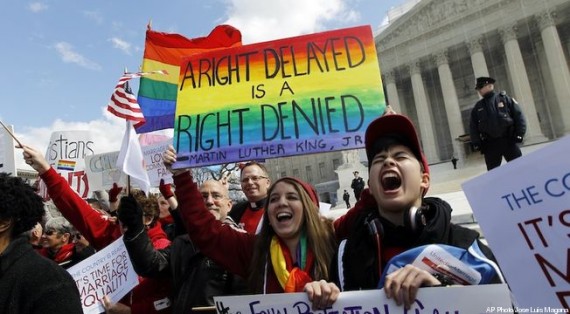

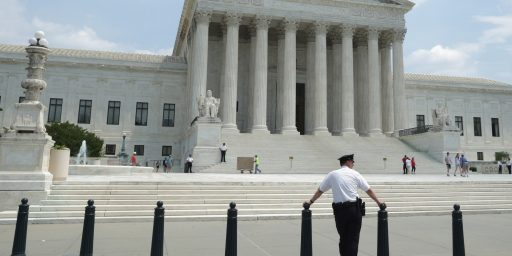
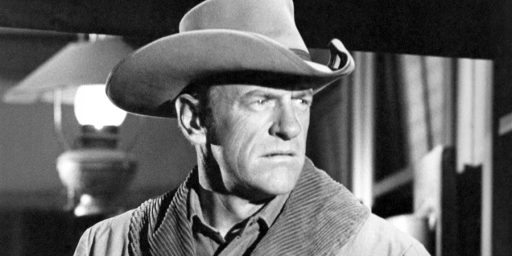
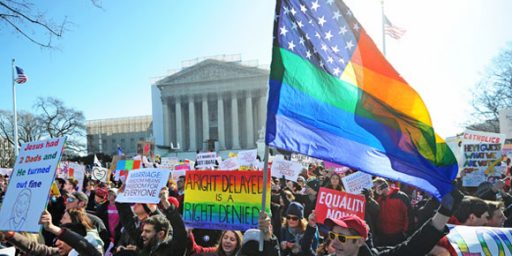

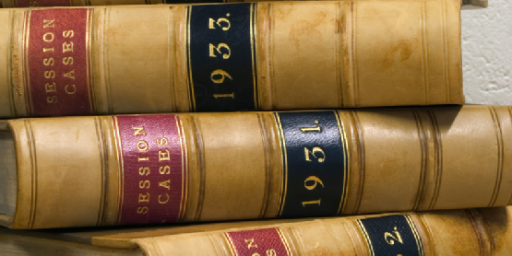
Let me get this straight, James. You don’t get the difference between Regulation Six, which regulates the “use of signs on the perimeter sidewalks on the Supreme Court grounds” and Regulation Seven, which “does not apply on the perimeter sidewalks on the Supreme Court grounds?”
Protests of any sort if peaceful should be allowed anywhere. Isn’t that what free speech is all about?
@Caj:
Provided that you are talking about *public spaces* you are entirely correct. Private spaces are an entirely different thing.
Plus, as with all constitutional rights, expressions of one’s rights are always regulated.
@Caj:
So can I protest in your living room, as long as I’m peaceful about it?
@Caj: @matt bernius: There are all manner of time, place, and manner restrictions on speech and, especially, assembly. So long as content neutral and not overly burdensome on speech, they’re generally permissible. And there are good security and practical reasons to restrict assembly on the steps of the Supreme Court. After all, SCOTUS isn’t even supposed to be a democratic body yet you can protest much closer to them than you can to the White House.
@Boyd: Good point. Glossed over that line.
@Caj: There is a large difference between “Free Speech” and “Freedom of Speech”. I’m aware that everyone uses the term “Free Speech” in conjunction with the First Amendment, but that’s wrong. “Free Speech” carries no possible penalties and under it such things as perjury could not be punished.